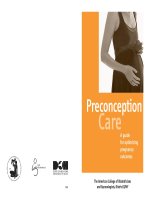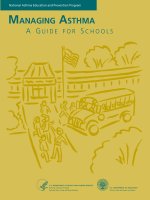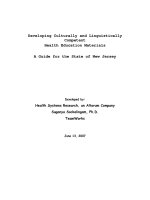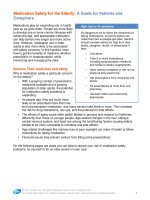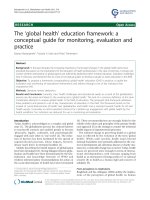Managing Newborn Problems: A Guide For Doctors, Nurses And Midwives docx
Bạn đang xem bản rút gọn của tài liệu. Xem và tải ngay bản đầy đủ của tài liệu tại đây (3.66 MB, 338 trang )
WHO Library Cataloguing-in-Publication Data
World Health Organization.
Managing newborn problems: a guide for doctors, nurses, and midwives
(Integrated management of pregnancy and childbirth)
1.Infant, Low birth weight 2.Infant, Newborn, Diseases - diagnosis 3.Infant,
Newborn, Diseases - therapy 4.Perinatal care - methods 5.Manuals I.Title
II,Series.
ISBN 92 4 154622 0 (NLM Classification: WS 420)
© World Health Organization 2003
All rights reserved. Publications of the World Health Organization can be
obtained from Marketing and Dissemination, World Health Organization, 20
Avenue Appia, 1211 Geneva 27, Switzerland (tel: +41 22 791 2476; fax: +41 22
791 4857; email: ). Requests for permission to reproduce or
translate WHO publications – whether for sale or for noncommercial distribution
– should be addressed to Publications, at the above address (fax: +41 22 791
4806; email: ).
The designations employed and the presentation of the material in this publication
do not imply the expression of any opinion whatsoever on the part of the World
Health Organization concerning the legal status of any country, territory, city or
area or of its authorities, or concerning the delimitation of its frontiers or
boundaries. Dotted lines on maps represent approximate border lines for which
there may not yet be full agreement.
The mention of specific companies or of certain manufacturers’ products does not
imply that they are endorsed or recommended by the World Health Organization
in preference to others of a similar nature that are not mentioned. Errors and
omissions excepted, the names of proprietary products are distinguished by initial
capital letters.
The World Health Organization does not warrant that the information contained
in this publication is complete and correct and shall not be liable for any damages
incurred as a result of its use.
Printed in Hong Kong
ACKNOWLEDGEMENTS
Primary contributors: Peter Cooper
Robert Johnson
Haroon Saloojee
Jelka Zupan
Contributors: Julia Brothers
Atanu Kumar Jana
Joy Lawn
Indira Narayanan
Chandrakant Ruparelia
Harshad Sanghvi
Achmad Surjono
Editor: Melissa McCormick
Editorial assistance: Sonia Elabd
Dana Lewison
Erin Wagner
Artist: Kimberly Battista
Graphic assistance
and layout: Deborah Raynor
Cover design: Máire Ní Mhearáin
Reviewers:
Youssef Al-Eissa
Deema Al Imam
Anna Alisjahbana
Saif Al-Saif
Duong Thi Cuong
Gary Darmstadt
Sylvia Deganus
A.M. Djauhariah
France Donnay
Trevor Duke
L. Haksari Ekawaty
Indarso Fatimah
Masanori Fujimura
Frances Ganges
Adenike Grange
Dasatjipta Guslihan
Petra ten Hoope-Bender
Ardi Kaptiningsih
M. Sholeh Kosim
Ornella Lincetto
Sandra MacDonagh
Viviana Mangiaterra
Marie Antonette Mendoza
Pius Okong
Kike Osinusi
Vinod K. Paul
Nicky Pereira
Chen RuJun
Suradi Rulina
Irina Ryumina
D. Setyowireni
Mamdouh Shaaban
Maryanne Stone-Jimenez
Haby Signaté Sy
Skender Syla
Ragnar Tunell
Ali Usman
Martin Weber
David Woods
John Wyatt
This guide represents a common understanding between WHO, UNFPA,
UNICEF, and the World Bank of key elements of an approach to reducing
newborn deaths and disabilities. These agencies cooperate closely in efforts to
reduce maternal and neonatal mortality and morbidity. The principles and policies
of each agency are governed by the relevant decisions of each agency’s governing
body, and each agency implements the interventions described in this document in
accordance with these principles and policies and within the scope of its mandate.
The guide has also been reviewed and endorsed by the International Pediatric
Association, the International Confederation of Midwives, and the International
Federation of Gynecology and Obstetrics.
International Pediatric
Association
International Federation of
Gynecology and Obstetrics
The financial support towards the preparation and production of this document,
provided by the Governments of Australia, Japan, and the United States of
America, is gratefully acknowledged, as is financial support received from The
World Bank. In addition, WHO’s Making Pregnancy Safer initiative is grateful for
the programme support received from the UNFPA and the Governments of The
Netherlands, Norway, Sweden, and the United Kingdom of Great Britain and
Northern Ireland.
WHO gratefully acknowledges the technical and editorial assistance provided by
staff of JHPIEGO’s Maternal and Neonatal Health Program, with funding
provided by the Maternal and Child Health Division, Office of Health, Infectious
Diseases and Nutrition, Bureau for Global Health, U.S. Agency for International
Development, under the terms of Award No. HRN-A-00-98-00043-00 and of
SOAG documents No. 497-0393 and 497-0008. WHO also acknowledges the
technical assistance provided by the Saving Newborn Lives Initiative and
BASICS II.
TABLE OF CONTENTS
Foreword v
Preface vii
Introduction ix
List of Abbreviations xiii
List of Diagnoses xv
List of Figures xvii
List of Tables xix
SECTION 1: ASSESSMENT, FINDINGS, AND MANAGEMENT
Organizing Care of the Sick or Small Newborn Baby F-1
Rapid Assessment and Immediate Management F-5
Further Assessment and Management F-7
Small Baby F-23
Multiple Findings (Most often Sepsis or Asphyxia) F-35
Breathing Difficulty F-47
Mother with History of Uterine Infection or Fever during Labour
or after Birth, or Rupture of Membranes for More than 18 Hours
before Birth F-55
Convulsions or Spasms F-59
Abnormal Body Temperature F-69
Jaundice F-77
Lethargy and Other Non-Specific Signs F-87
Low Blood Glucose F-91
Feeding Difficulty F-93
Vomiting and/or Abdominal Distension F-99
Diarrhoea F-107
Bleeding and/or Pallor F-113
Swelling on Scalp F-121
Skin and Mucous Membrane Problems F-127
Umbilicus Red and Swollen, Draining Pus, or Foul Smelling F-135
Eyes Red, Swollen, or Draining Pus F-139
Birth Injury F-145
ii
Table of contents
Birth Defects F-151
Asymptomatic Newborn Baby of Mother with Hepatitis B,
Tuberculosis, Diabetes, or Syphilis F-155
Mother with HIV F-159
SECTION 2: PRINCIPLES OF NEWBORN BABY CARE
Maintaining Normal Body Temperature C-1
Feeding and Fluid Management C-11
Oxygen Therapy C-25
Antibiotics C-31
Infection Prevention C-37
Clinical Use of Blood C-47
Immunization C-51
Assessing Growth C-53
Communication and Emotional Support C-57
Transfer and Referral C-63
Discharge and Follow-Up C-67
SECTION 3: PROCEDURES
Resuscitating a Baby Who Was Breathing P-1
Measuring Body Temperature P-5
Taking Blood Samples P-9
Measuring Blood Glucose P-13
Giving Injections P-15
Establishing an Intravenous Line P-21
Transfusing Blood P-31
Inserting a Gastric Tube P-33
Performing a Lumbar Puncture P-37
Administering Rectal Paraldehyde P-41
Draining an Abscess P-43
iii
Table of contents
SECTION 4: APPENDIX
Record Keeping A-1
Essential Equipment, Supplies, and Drugs A-9
Index A-15
iv
Table of contents
Foreword
PREFACE vii
This guide has been produced by the World Health Organization to assist
countries with limited resources in their efforts to reduce neonatal mortality
and to ensure care for newborn babies with problems due to complications of
pregnancy and childbirth, such as asphyxia, sepsis, and low birth weight or
preterm birth.
The main section of this guide is arranged by clinical signs or findings, which
facilitates early identification of illness, and provides up-to-date guidelines
for clinical management. Use of these guidelines is essential in promoting and
assessing the quality of health services and training providers and supporting
quality services through supervision and feedback on performance.
The interventions in this guide are based on the latest available scientific
evidence and the guide will be updated as new information is acquired. In
addition, the diagnostic and management guidelines in this guide are
consistent with the other WHO materials in the Integrated Management of
Pregnancy and Childbirth (IMPAC) series, including Pregnancy, Childbirth,
Postpartum and Newborn Care: A Guide for Essential Practice and
Managing Complications in Pregnancy and Childbirth: A Guide for
Midwives and Doctors. This guide is complementary to the Integrated
Management of Childhood Illness (IMCI) guidelines for care of the sick
young infant: the major illnesses emphasized in this guide originate at birth or
during the first week of life, while the illnesses covered in the IMCI
guidelines generally originate after that period.
It is hoped that this guide will be readily available whenever a doctor, nurse,
or midwife is confronted with a sick or small newborn baby. In addition, all
of the guides in the IMPAC series can be used by national ministries of health
to help ensure that countries have state-of-the-art information upon which to
base their national policy standards, pre-service training, and service delivery
guidelines.
For the guide to be fully effective, its users should also be trained in a setting
where skills can be practised. Many training packages and job aids are
available to accompany the guides in the IMPAC series.
viii
Preface
INTRODUCTION ix
A newborn baby who is small or has a potentially life-threatening problem is
in an emergency situation requiring immediate diagnosis and management.
Delay in identification of the problem or in providing the correct management
may be fatal. This guide provides up-to-date, authoritative clinical guidelines
for use at the first referral level in low-resource settings by the doctors,
nurses, midwives, and other health care workers who are responsible for the
care of newborn babies with problems during the first week(s) of life. The
guide can also be used to identify less common conditions that require
referral to a higher level.
To effectively apply these guidelines for care of the sick or small newborn
baby, a general medical officer and nurses with skills in caring for newborn
babies should be available at the hospital 24 hours per day. In addition, basic
support systems are necessary, including:
• Basic laboratory capabilities for measurement of haemoglobin or
haematocrit (erythrocyte volume fraction), blood glucose, and serum
bilirubin, as well as culture and sensitivity of blood, pus, and
cerebrospinal fluid;
• Selected essential drugs, including key antibiotics such as ampicillin and
gentamicin;
• Essential equipment and supplies, including accurate weighing scales and
a microdropper for infusions;
• Capability to provide safe blood transfusion.
In certain settings, these requirements may not be available; this guide allows
for these situations and provides alternative methods of assessment or
management where possible. However, all health care workers and policy-
makers are encouraged to strive for wider availability of these basic standards
to enable effective care of sick and small newborn babies.
HOW TO USE THE GUIDE
The emphasis of the guide is on rapid assessment and decision-making, in
order to prioritize the sickest babies and the most urgent actions.
• The first priority is to immediately assess all babies for emergency (life-
threatening) signs and identify those who require immediate
management.
x
Introduction
• A further assessment, including history and a complete examination, is
then necessary to guide the health care worker in identifying appropriate
management for the specific problem(s) identified.
The main text of the guide is arranged primarily by clinical signs or findings
(e.g. breathing difficulty). Because this approach is different from most
medical texts, which are arranged by disease categories, a list of diagnoses
with the page number of the corresponding diagnosis table is provided. The
guide comprises four sections, each numbered separately and designated with
a letter code. Cross-referencing is used extensively throughout the text to
allow the reader to quickly find the relevant information in all sections of the
manual.
Section 1, Assessment, Findings, and Management (designated by the
letter “F” in page numbers), contains a short chapter used to identify those
babies at risk of dying very soon and provides initial guidance on immediate
management necessary to stabilize the baby’s condition. This section also
includes a description of the further assessment necessary to identify the
baby’s specific problem(s) and includes relevant history questions and a
complete physical examination. A table guides the health care worker through
the examination, provides guidance on initial management when necessary,
and then directs the health care worker to the most appropriate chapter(s) for
management of the specific problem(s). The following chapters, with a few
exceptions, explore each sign or finding separately.
Most chapters begin with general management (where appropriate) followed
by a differential diagnosis table that guides the health care worker to the most
probable diagnosis that is causing the problem. The findings from the history,
examination, and laboratory investigations (or other known diagnoses) are
listed separately in each table. To help the user determine the significance of
the possible findings, italics and bold text are used to distinguish between
findings: a diagnosis cannot be made if a finding listed in bold text is absent
in the baby. The presence of a finding listed in bold, however, does not
guarantee the diagnosis. The diagnosis is definitively confirmed if a finding
listed in italicized text is present. Findings in plain text are supportive
findings; their presence helps to confirm the diagnosis, but their absence
cannot be used to rule out the diagnosis.
Simplified management protocols follow the diagnosis tables. Where there
are several choices of therapy, the most effective and inexpensive is chosen.
Clear guidance on drugs and dosages, as well as alternatives, is provided.
Conditions requiring referral to a higher level are included in the examination
table and in individual chapters where appropriate.
xi
Introduction
Section 2, Principles of Newborn Baby Care (designated by the letter “C”
in page numbers), outlines the general principles of managing sick or small
newborn babies. This section includes the general principles of ongoing care,
including feeding, maintaining normal body temperature, preventing
infection, giving immunizations, and assessing growth. Other chapters
provide guidance on giving oxygen, antibiotics, and blood transfusion.
Guidance on emotional support, visitation, and discharge and follow-up is
also included.
Section 3, Procedures (designated by the letter “P” in page numbers),
describes the procedures that may be necessary in the care of the sick or small
baby. These procedures are not intended to be detailed “how-to” instructions,
but rather a summary of the main steps associated with each procedure.
Because the general principles of care are summarized in Section 2, these are
not repeated for each procedure unless specific to the procedure.
Section 4, Appendix (designated by the letter “A” in page numbers),
contains sample records and a list of essential equipment, supplies, and drugs.
An index is included and is organized so that it can be used in an emergency
situation to find relevant material quickly. The most critical information,
including diagnosis, management, and relevant procedure(s), is listed first in
bold. Other entries follow in alphabetical order. Only the pages containing
critical or relevant information are included, rather than listing every page
that contains the word or phrase.
xii
Introduction
LIST OF ABBREVIATIONS xiii
ABO the major human blood type system
AIDS acquired immunodeficiency syndrome
BCG bacille Calmette-Guérin (for immunization against tuberculosis)
CSF cerebrospinal fluid
DPT diphtheria, pertussis, and tetanus vaccine
F French scale
G6PD glucose-6-phosphate dehydrogenase
HbsAg hepatitis B surface antigen
HBV hepatitis B virus
HIV human immunodeficiency virus
IM intramuscular
IV intravenous
KMC kangaroo mother care
OPV oral polio vaccine
ORS oral rehydration solution
Rh Rhesus
°C degrees Celsius
µmol micromolar/micromole
dl decilitre
g gram
kg kilogram
l litre
mg milligram
ml millilitre
mmol millimolar/millimole
xiv
List of abbreviations
LIST OF DIAGNOSES xv
Abrasion F-132
Abscess F-130
Anaemia of a sick or
small baby F-119
Apnoea F-52
Arm palsy F-147
Asphyxia F-44
Bilirubin encephalopathy F-83
Birth defect F-151
Birth mark F-151
Birth weight, low F-23
Blood glucose, low F-91
Blood loss from obstetric
causes F-119
Breathing difficulty F-47
Caput succedaneum F-124
Cellulitis F-130
Cephalohaematoma F-124
Chignon F-124
Cleft lip or palate F-151
Club foot F-152
Coagulopathy F-119
Congenital heart abnormality F-52
Congenital syphilis F-46
Conjunctivitis F-142
Cut F-132
Diarrhoea F-107
Drug-induced lethargy F-89
Extra finger(s) or toe(s) F-151
Facial palsy F-148
Feeding difficulty in small
baby or twin F-96
Fractured clavicle F-150
Fractured femur F-150
Fractured humerus F-149
Gastric irritation F-106
Gastrointestinal malformation
or obstruction (suspected) F-105
Gastroschisis F-152
Genetic birth defect F-153
Haemolytic jaundice F-81
Haemorrhagic disease of
the newborn baby F-119
Hyperthermia F-73
Hypoglycaemia F-91
Hypothermia, moderate F-72
Hypothermia, severe F-71
Imperforate anus F-153
Inadequate weight gain F-96
Incorrect positioning and
attachment to breast F-96
Intraventricular bleeding F-66
Jaundice of prematurity F-82
Kernicterus F-83
Low birth weight F-23
Low blood glucose F-91
Meningitis F-43
Meningomyelocoele F-152
Mother with diabetes F-156
Mother with hepatitis B F-155
Mother with history of rupture
of membranes for more
than 18 hours before birth F-55
Mother with history of uterine
infection or fever during
labour or after birth F-55
Mother with HIV F-159
Mother with syphilis F-157
Mother with tuberculosis F-155
Necrotizing enterocolitis F-104
Omphalocoele F-152
Pallor of unknown origin F-119
Prematurity F-23
Prolonged jaundice F-83
Respiratory distress syndrome F-51
Sepsis F-41
Skin infection F-129
Skin tag F-151
Small baby F-23
Spina bifida F-152
Subaponeurotic (subgaleal)
haemorrhage F-123
xvi
List of diagnoses
Swallowed maternal blood F-105
Syphilis, congenital F-46
Tetanus F-66
Thrush F-131
Umbilical cord infection, local F-137
Umbilical cord infection, severe F-136
LIST OF FIGURES xvii
SECTION 1: ASSESSMENT, FINDINGS, AND MANAGEMENT
Figure F-1 Normal resting posture of small (A) and term (B) babies F-23
Figure F-2 Baby in kangaroo mother care position under
mother’s clothes F-32
Figure F-3 Chest indrawing F-47
Figure F-4 Babies with spasms of the face and limbs (A) and
opisthotonos (B) F-60
Figure F-5 Baby under phototherapy lights F-85
Figure F-6 Abdominal distension F-99
Figure F-7 Moulding of the baby’s head F-121
Figure F-8 Baby with unilateral cephalohaematoma F-125
Figure F-9 Baby with abrasions from forceps delivery F-132
Figure F-10 Abnormal position of arm and hand F-145
Figure F-11 Baby unable to wrinkle forehead or close eye on
affected side F-145
Figure F-12 Normal resting posture of a breech baby F-146
Figure F-13 Splinting a fractured humerus F-149
Figure F-14 Splinting a fractured femur F-150
SECTION 2: PRINCIPLES OF NEWBORN BABY CARE
Figure C-1 Radiant warmer C-6
Figure C-2 Incubator C-7
Figure C-3 Encouraging the baby to attach to the breast C-13
Figure C-4 Correct (A) and incorrect (B) attachment to the breast C-14
Figure C-5 Expressing breast milk C-16
Figure C-6 Feeding by cup (A), paladai (B), or cup and spoon (C) C-17
Figure C-7 Feeding expressed breast milk by gastric tube C-19
Figure C-8 Baby receiving oxygen via a head box C-28
Figure C-9 Blank weight chart C-55
Figure C-10 Example of a completed weight chart C-56
xviii
List of figures
SECTION 3: PROCEDURES
Figure P-1 Correct position of the head for ventilation P-2
Figure P-2 Positioning the mask and checking the seal P-3
Figure P-3 Measuring axillary temperature P-6
Figure P-4 Measuring rectal temperature P-6
Figure P-5 Site for heel prick P-12
Figure P-6 Intramuscular injection into quadriceps muscle group P-17
Figure P-7 Using a rubber band as a tourniquet for scalp vein P-22
Figure P-8 Immobilizing the hand P-23
Figure P-9 Securing butterfly set in place P-24
Figure P-10 Inserting an umbilical vein catheter P-26
Figure P-11 Intraosseous infusion P-29
Figure P-12 Measuring gastric tube for oral (A) and nasal (B) routes P-34
Figure P-13 Inserting oral gastric tube P-34
Figure P-14 Securing oral (A) and nasal (B) gastric tube in place P-35
Figure P-15 Sitting position for lumbar puncture P-38
Figure P-16 Lying position for lumbar puncture P-38
Figure P-17 Site of lumbar puncture P-39
SECTION 4: APPENDIX
Figure A-1 Clinical record of ongoing care A-2
Figure A-2 Discharge form A-3
Figure A-3 Referral form A-4
Figure A-4 Feedback form A-5
Figure A-5 Death certificate A-7
LIST OF TABLES xix
SECTION 1: ASSESSMENT, FINDINGS, AND MANAGEMENT
Table F-1 Immediate management of emergency signs F-6
Table F-2 Examination of the newborn baby F-11 to F-20
Table F-3 Volumes of breast milk for a baby weighing 1.5 to
1.749 kg without major illness F-27
Table F-4 Volumes of breast milk for a baby weighing 1.25 to
1.49 kg without major illness F-27
Table F-5 Volumes of IV fluid and breast milk for all babies
weighing less than 1.25 kg F-28
Table F-6 Volumes of IV fluid and breast milk for a sick baby
weighing 1.75 to 2.5 kg F-28
Table F-7 Volumes of IV fluid and breast milk for a sick baby
weighing 1.5 to 1.749 kg F-29
Table F-8 Volumes of IV fluid and breast milk for a sick baby
weighing 1.25 to 1.49 kg F-29
Table F-9 Findings common to sepsis and asphyxia F-37
Table F-10 Findings characteristic of babies who are small or have
congenital syphilis F-37
Table F-11 Summary of decision-making pathway to distinguish
sepsis from asphyxia F-40
Table F-12 Classification of breathing difficulty F-49
Table F-13 Distinguishing features of convulsions and spasms F-60
Table F-14 Differential diagnosis of convulsions or spasms F-62 to F-63
Table F-15 Differential diagnosis of abnormal body temperature F-70
Table F-16 Clinical estimation of severity of jaundice F-78
Table F-17 Treatment of jaundice based on serum bilirubin level F-79
Table F-18 Differential diagnosis of jaundice F-80 to F-81
Table F-19 Differential diagnosis of non-specific signs F-89
Table F-20 Differential diagnosis of feeding difficulty F-94 to F-95
Table F-21 Differential diagnosis of vomiting and/or abdominal
distension F-101 to F-103
Table F-22 Differential diagnosis of diarrhoea F-109 to F-110
Table F-23 Differential diagnosis of bleeding and/or pallor F-115 to F-118
Table F-24 Differential diagnosis of swelling on scalp F-122
Table F-25 Differential diagnosis of skin and mucous membrane
problems F-128
Table F-26 Classification of severity of infection of umbilicus F-136
Table F-27 Differential diagnosis of conjunctivitis F-141
Table F-28 Differential diagnosis of birth injury F-147
xx
List of tables
SECTION 2: PRINCIPLES OF NEWBORN BABY CARE
Table C-1 Measuring body temperature C-2
Table C-2 Methods for warming the baby and maintaining body
temperature C-2 to C-5
Table C-3 Recommended incubator temperatures C-7
Table C-4 Total daily feed and fluid volumes for babies from birth C-22
Table C-5 Methods for administering oxygen C-25
Table C-6 Sources of oxygen C-29
Table C-7 Antibiotics used to treat infections described in this guide C-32
Table C-8 Antibiotic dilutions C-33
Table C-9 Antibiotic doses C-34 to C-35
Table C-10 Acceptable antiseptic and disinfectant solutions C-41
Table C-11 Guidelines for processing instruments and equipment C-43
Table C-12 Sample cleaning schedule for the newborn special care unit C-44
Table C-13 Suggested equipment, supplies, drugs, and fluid for
transfer of a sick or small baby C-64
SECTION 1: ASSESSMENT, FINDINGS, AND MANAGEMENT

